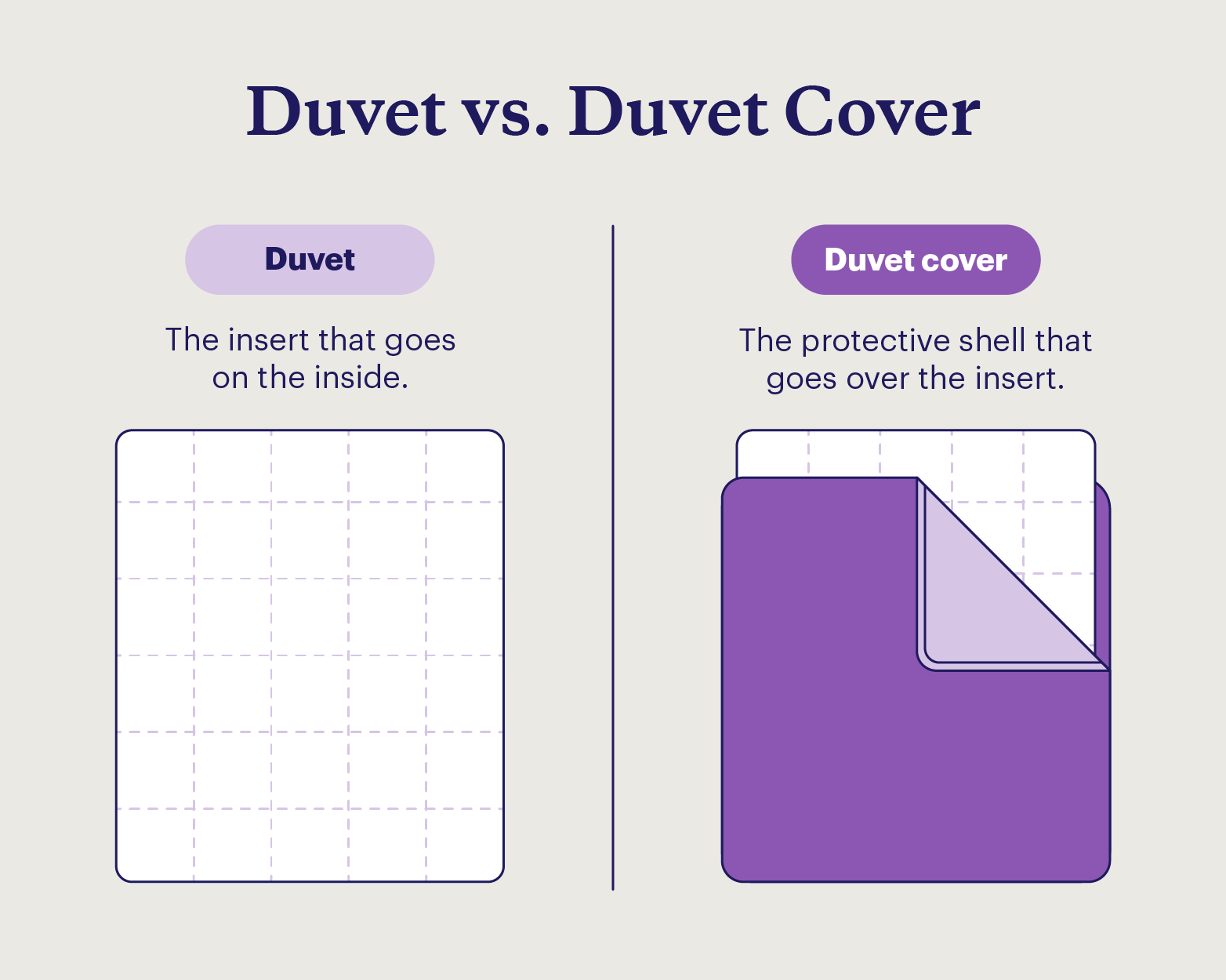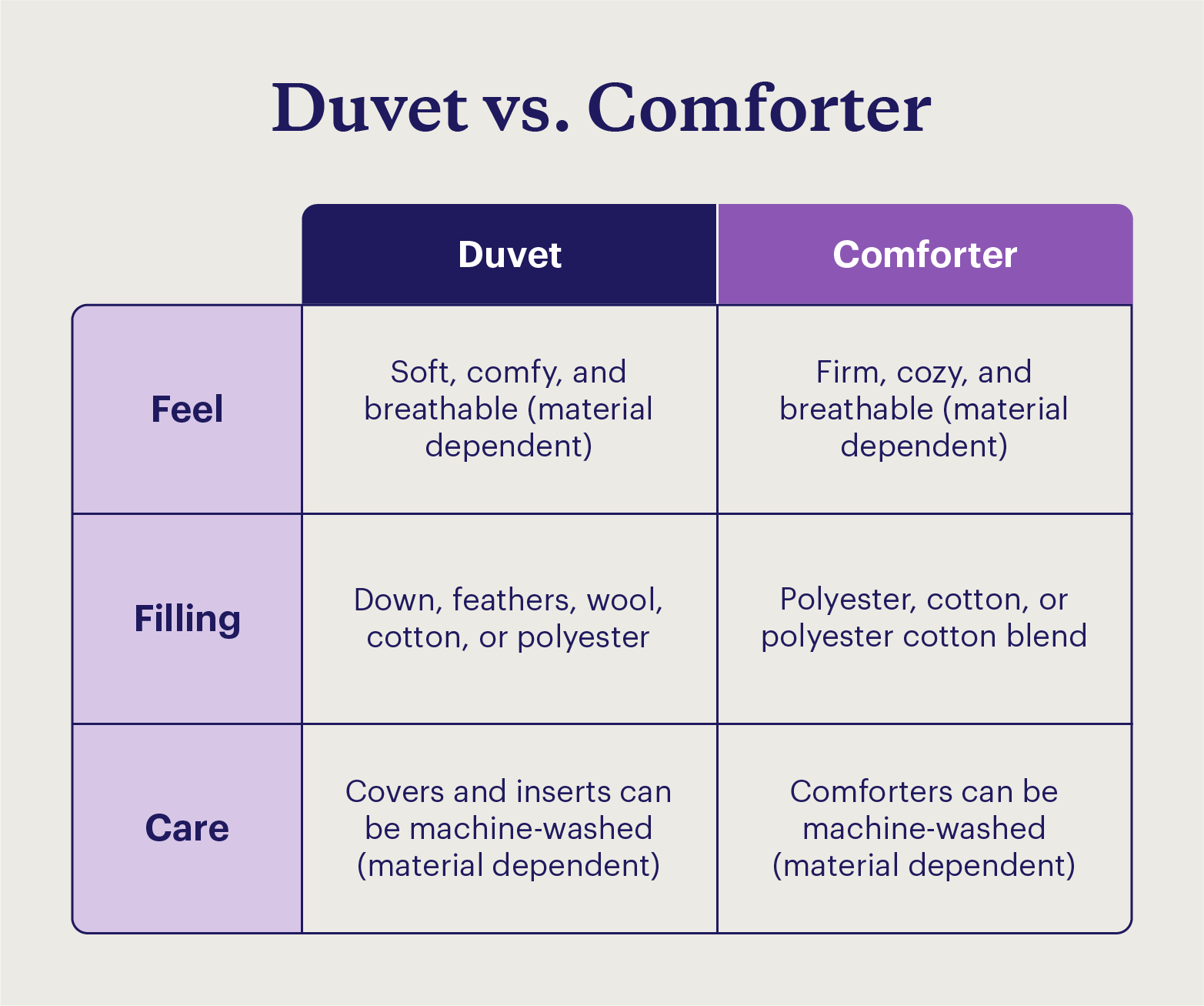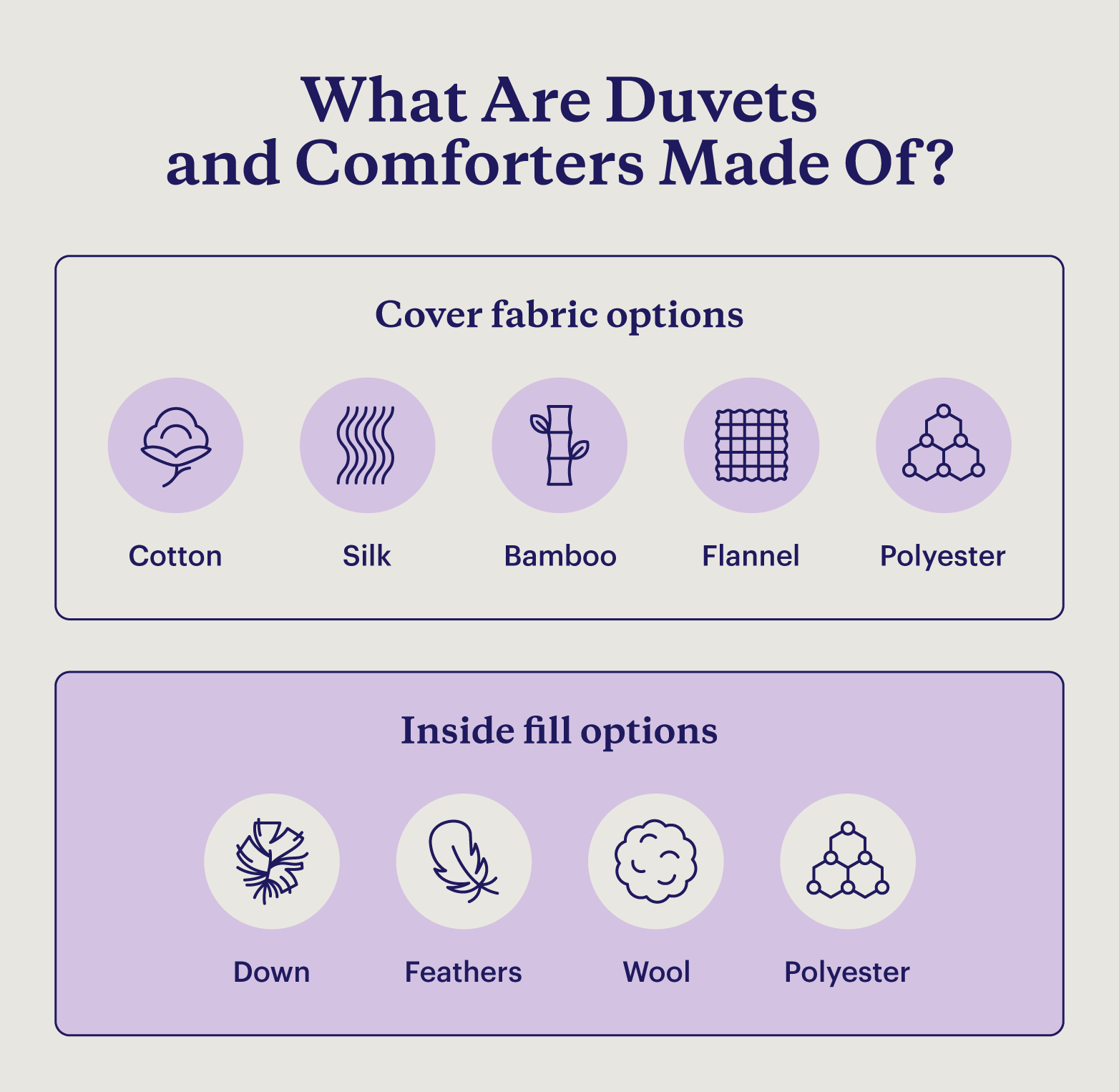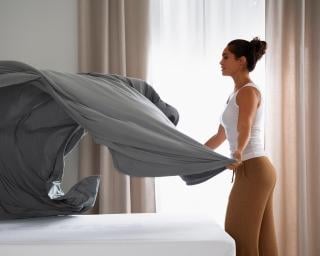
Duvet vs. Comforter: What Is a Duvet + Key Differences
Key Takeaways
- A duvet is a type of blanket utilizing a multi-layered fabric filled with stuffing made from natural or synthetic fibers.
- Duvet inserts go into a duvet cover for added warmth, comfort, and protection.
- A comforter is one piece of bedding made of a cloth exterior and filled with soft, synthetic fibers.
- The differences between duvets and comforters are that duvets have layers, require a duvet cover, and come in a variety of weights.
With countless bedding options available, it's easy to get confused and difficult to know where to start. This blog provides you with a thorough look into two primary bedding options most considered by consumers.
One of which is the duvet — a quilt filled with stuffing that adds comfiness, coziness, and warmth. This pillow-like filling typically consists of natural fibers like feathers, down, wool, or even synthetic alternatives, like microfiber or hollow fiber.
The second choice is the comforter, a single piece of bedding that doesn’t require an outer shell or cover, like a duvet.
Read on to learn everything you need to know about duvets and comforters, including their similarities and differences.
What Is a Duvet Cover?
A duvet cover is a protective layer for a duvet. It consists of two pieces of thin material sewn together with an opening at one end for inserting a duvet. They are easy to remove, store, and wash by machine.
Using a duvet is easy: simply insert your duvet inside your duvet cover and seal up the open end, typically with buttons or a zipper. While it might seem like extra work compared to a blanket or comforter, this design has a purpose.
A removable cover ensures the duvet stays clean, limits the need to wash the heavy duvet insert, and allows you to select an aesthetic cover of your choosing.
In comparison, comforters, which are made from the same materials as a duvet insert, are not protected by a cover and require regular cleaning that oftentimes proves difficult.
Duvet covers can be made from cotton, silk, bamboo fibers, flannel, or polyester. For a good night’s sleep, a breathable material is key. Our hypoallergenic PerfectStay™ Duvet Cover Set ensures optimal temperatures throughout the night by retaining heat when cool and releasing heat when warm.
Benefits | Considerations |
| Soft and cozy because of inner stuffing | Prone to sliding inside the duvet cover if not secured |
| Easy to keep a duvet insert clean because an easily removable cover protects it | Require a cover, often sold separately |
| Simply change your bedding style by replacing the cover | Can be a hassle to take most duvet covers off and put them on |
What Is a Duvet?
A duvet is a plush, stuffed type of blanket that goes inside a duvet cover. Duvet inserts are sometimes called “down comforters.”
Duvets, or “duvet inserts,” provide warmth, comfort, and ease of use. Unlike blankets, duvet inserts use stuffing materials like down feathers, wool, cotton, or polyester stuffing for added fluff and bulk that many sleepers find cozier.
Keep in mind that stuffing materials will highly influence the price of your duvet. For example, down is generally the most expensive stuffing, but it can provide added comfort and breathability.
Purple’s TempBalance™ Duvet uses a hypoallergenic down alternative. You can sleep comfortably all year round with this temperature-regulating duvet. Our quilted design keeps the duvet filling in place, so the typical annoyance of duvet movement is not a concern.
What Is a Comforter?
A comforter is a single piece of bedding that goes over your sheets. The typical comforter is a blanket consisting of a cloth exterior filled with soft, synthetic fibers. It typically serves as the top layer of bedding over your sheets. Available in a variety of sizes and thread counts, comforters offer ample range for creating your bedding aesthetic.
Benefits | Considerations |
| You only need to buy one piece | Can be hot and stuffy on warmer nights |
| Easier to store than duvets | More effort to clean |
| Often comes in a set with matching sheets and bedding | No option to change the cover if there’s a spill or stain |
| The filling is consistently distributed for predictable coverage |
Differences Between Duvet and Comforter
The main difference between duvets and comforters is that duvets use a cover and comforters do not. Comforters use the same materials as a duvet, but duvets are thicker than comforters. Retailers sometimes use “comforter” for “duvet” and vice versa, which can prove confusing.
While duvets may require more pieces than a comforter, their design can save you time as they are easier to clean due to their removable covers. With a duvet, you simply remove the cover and wash it, whereas comforters are full of materials, so washing them can be time-consuming and problematic.
Duvet Cover Size vs. Comforter Size
While duvets appear fuller on your bed, they actually tend to be slightly smaller than comforters, providing a “flush” fit. In comparison, comforters are designed to hang over the sides of your bed slightly. Both duvets and comforters are available in every mattress size.
Use the table below to better understand duvet and comforter standard sizes:
Size | Duvet | Comforter |
Twin/Twin XL | 90" x 66" | 86" x 66" to 88”x 86” |
Full/Queen | 90" x 90" | 96" x 86" to 100” x 88” |
King/Cal King | 104" x 90" | 102" x 86" to 107” x 96” |
Sizes for duvets and comforters can vary slightly based on manufacturers. Many manufacturers size up or down from the norm by a few inches so be sure to confirm sizes per option.
It’s also important to know your mattress size when selecting bedding. If you have a thicker mattress, opt for a larger duvet or comforter to ensure proper coverage around the edges.
How To Choose The Right Duvet vs. Comforter
There are a variety of options for duvets and comforters, which all satisfy different wants and needs. Your final choice needs to suit your particular sleeping style and preferences.
Use this guide to choose the right duvet or comforter for you.
1. Material
Stuffing material is a crucial factor, especially if you want to use your duvet or comforter year-round. For example, hot sleepers might prefer a down alternative as this material is more temperature-regulating, while cold sleepers might prefer down.
The primary choices for duvet insert or comforter filling include:
- Down alternative (usually a polyester material): comfy, durable, temperature-regulating, easy to wash
- Down: fluffy, comfy, some are machine-washable
- Down and feather blend: fluffy, comfy, some are machine-washable
- Wool: breathable, soft, some are machine-washable
- Polyester: less breathable, more durable, easy to wash
2. Size
To determine your blanket’s size, measure your bed. Your duvet insert or comforter should be larger than your bed’s dimensions. Manufacturers may use “queen size” to describe their duvet inserts, but it’s not always consistent between brands.
First, ensure your blanket is longer and wider than your mattress. Then, consider your mattress height and how you want to style your bed. A properly sized duvet or comforter should cover the sides of your mattress without touching the floor.
3. Warmth
You may have seen “fill weight” and “fill power” used to describe down or other types of filling. A fill power score indicates how fluffy a down filling is on a scale of 300-900, with 900 being the highest quality. A high number means high-quality insulation, with 600 and upwards typically denoting a high-quality option.
Fill weight tells you how heavy a down filling is, but it’s less reliable for measuring warmth. You can use fill weight to find your preferred density, but fill power is better for determining the quality of a blanket’s insulation.
A high-quality filling lets you enjoy a duvet or comforter year-round. Purple’s TempBalance™ Duvet uses a special temperature-regulating material for this purpose. Our down alternative provides all the comfort and convenience you need for a good night’s sleep.
4. Convenience
Those who dislike the process of properly inserting a duvet into its insert may find using a comforter more convenient. However, you’ll have to use a top sheet with a comforter to avoid washing a comforter as often.
Additionally, if you want to switch your comforter seasonally or for aesthetic reasons, you’ll need more storage space than you would with duvet covers.
Duvet covers and inserts have a reputation for moving around, but this shouldn’t happen if you secure them. The best duvet inserts allow you to secure the duvet covers and inserts at each corner.
The common options for securing duvets are:
- Ties
- Clips
- Loops
Metal or plastic clips are easy enough to secure, but they can be bulky due to their material. Most duvets come with ties or loops, but this varies by brand.
Purple’s soft-touch Velcro is the best of both worlds. Soft-touch Velcro keeps your duvet insert from moving without the need for bulky clips or fussy ties.
5. Cost
Duvet inserts can cost anywhere from $50-$1,000, depending on the filling materials, fill weight, size, and brand. Pricier inserts use down, while less expensive options usually use synthetic materials, like polyester.
Purple’s duvet inserts range from $229 for a twin/twin XL size to $279 for a king/California king. Every insert uses our down alternative for superior comfort at a friendlier cost.
Comforters may be a bit more expensive, ranging from $30 to over $500. However, you’ll have to replace the entire item instead of just the duvet cover if it gets damaged or stained.
6. Cleaning
When it comes to duvet vs. comforter care, the duvet takes top place for ease of cleaning. A duvet cover eliminates the need to wash the bulky duvet insert. The cover is easy to remove and wash making maintenance of your bedding much more effortless. By contrast, a comforter requires additional cleaning since it doesn’t have a protective cover. Getting a bulky comforter into a washing machine can be a Herculean task, most often requiring a trip to the dry cleaners. Additionally, replacing a duvet cover is much easier than replacing an entire comforter.
What Is the Best Duvet Insert for Hot Sleepers?
The best duvet insert for hot sleepers is one filled with temperature-regulating stuffing. Down-stuffed inserts with a high fill power and low fill weight can provide comfort without trapping too much heat.
Purple’s TempBalance™ Duvet is the perfect duvet insert for hot sleepers. Our easy-to-use soft-touch Velcro makes cleaning your duvet cover a breeze, and our down alternative gives you all the warm, cozy benefits of down without pokey feathers.












